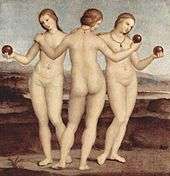1505 in art
The year 1505 in art involved some significant events and new works.
| |||
|---|---|---|---|
|
Events
- Pope Julius II summons Michelangelo to Rome to design the pope's tomb. The contract is revised five times and only three of forty large figures are ever executed.
Works
.jpg)
 Bosch, St. Jerome at Prayer
Bosch, St. Jerome at Prayer
- Riemenschneider, Holy Blood altarpiece
Many dates approximate
- Giovanni Bellini
- Hieronymus Bosch
- The Hermit Saint (triptych)
- St. Jerome at Prayer
- Vittore Carpaccio
- Holy Family and donors
- Preparation of Christ's Tomb
- Piero di Cosimo
- The Finding of Vulcan on Lemnos
- The Adoration of the Christ Child
- The Forest Fire
- Albrecht Dürer - Portrait of a Young Venetian Woman
- Giorgione - The Three Philosophers
- Leonardo da Vinci – The Battle of Anghiari (lost painting)
- Lorenzo Lotto
- Andrea Previtali – Scenes from Tebaldeo's Eclogues
- Raphael
- Tilman Riemenschneider - Holy Blood altarpiece, St. James's Church, Rothenburg ob der Tauber (woodcarving, completed)
- Portrait of Henry VII of England
Births
- date unknown
- Pomponio Amalteo, Italian painter of the Venetian school (died 1588)
- Lambert Lombard, Flemish Renaissance painter, architect and theorist for the Prince-Bishopric of Liège (died 1566)
- Jakob Seisenegger, Austrian portrait painter used by Charles V (died 1567)
- probable
- Cornelis Anthonisz., Dutch painter, engraver and mapmaker (died 1553)
- Pierre Bontemps, French sculptor (died 1568)
- Matthys Cock, Flemish landscape painter (died 1548)
- Juste de Juste, Franco-Italian sculptor and printmaker in etching (died 1559)
- Jacques du Broeucq, Dutch sculptor and architect (died 1584)
- Léonard Limousin, French painter, member of Limoges enamel painter family (died 1577)
Deaths
- date unknown
- Andrea Aleksi, Albanian architect, painter and sculptor (born 1425)
- Matteo de Fedeli, Italian Renaissance painter (born 1450)
- Filippo Mazzola, Italian Renaissance painter (born 1460)
- Francesco Marmitta, Italian painter and jeweller (born 1460)
- Ni Duan, Imperial Chinese painter of people and landscapes (born 1436)
- probable - Bartolomeo Caporali, Italian painter (born 1420)
gollark: primes = apiophosphobalneometapathopetroform.
gollark: I hope you don't do something like... encode the entire state of the lemonocurrency system into every bill.
gollark: Security through obscurity bad, so you should probably have OTHER things?
gollark: *Whæt* œthær ways, exæctly?
gollark: various apioforms.
This article is issued from Wikipedia. The text is licensed under Creative Commons - Attribution - Sharealike. Additional terms may apply for the media files.